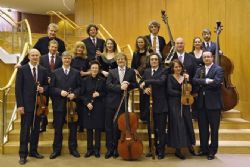|
Symphony
FROM THE NEW WORLD TO THE OLD WORLD
by Peter Lert
Saturday, June 14, 2025
Chamber
MC2 DUO RECITAL CLOSES 222'S SEASON
by Terry McNeill
Saturday, June 14, 2025
Choral and Vocal
CANTIAMO SONOMA'S LUSCIOUS A CAPELLA SINGING IN SEASON ENDING CONCERT
by Pamela Hicks Gailey
Sunday, June 8, 2025
Symphony
SRS SEASON ENDS WITH RESOUNDING TA-TA-TA-BANG
by Terry McNeill
Sunday, June 1, 2025
Symphony
YOUTHFUL VIRTUOSITY ON DISPLAY AT USO'S MAY CONCERTS
by Peter Lert
Saturday, May 17, 2025
Symphony
MYSTICAL PLANETS AND LIVELY GERSHWIN ORTIZ AT FINAL SRS CONCERT
by Peter Lert
Sunday, May 4, 2025
Symphony
VSO'S CONCERT MUSIC OF TIME, MUSIC OF PLACE
by Peter Lert
Sunday, April 27, 2025
VOCAL ELEGANCE AND FIRE AT THE 222'S RECITAL APRIL 26
by Pamela Hicks Gailey
Saturday, April 26, 2025
CANTIAMO SONOMA SINGS AN INSPIRED GOOD FRIDAY MOZART REQUIEM CONCERT
by Pamela Hicks Gailey
Friday, April 18, 2025
DRAMATIC SHOSTAKOVICH SYMPHONY CLOSES PHILHARMONIC'S 25TH SEASON
by Terry McNeill
Sunday, April 13, 2025
|
 |
 Concerto Kõln |
CONCERTO KÖLN DELIGHTS WITH RARELY-HEARD BAROQUE WORKS
by Joanna Bramel Young
Saturday, April 11, 2015
Weill Hall resonated April 11 with an agreeable group of Baroque works not often heard, though the composers are in fact well known. This assured, skilled plumbing of quiet corners of the repertoire is the specialty of Concerto Köln, based in Cologne, Germany, but received with pleasure throughout the world. The number of musicians forming the ensemble apparently varies from time to time, and Weill’s small yet ardent audience welcomed twenty-one, all gifted and polished performers.
Founded in 1985 by like-minded graduates of European colleges, the ensemble has no permanent conductor, although it does have an Artistic Director--Martin Sandhoff. In this program, concertmistress Mayumi Hirasaki, with both body language and spirited violin work, led the way through the lively program.
Two instruments rarely heard in Baroque music, harp and mandolin, were showcased. A Vivaldi concerto for Mandolin, Violin, and Strings (an arrangement of a concerto for oboe, violin and strings) was not the “famous” one that many of us have heard, but it was delightful in any event. Arrangements of works for other instruments were commonly crafted by Baroque composers, including Bach and Handel, to accommodate the occasion. Also on the program was Concerto for Harp and Strings, which Handel had originally composed as an organ concerto.
The opening work of the evening was Telemann’s Concerto for Flute, Violin, Strings and Bass in D Major, wherein flutist Wilbert Hazelzet soloed with Ms. Hirasaki. As was typical for eighteenth-century ensembles, all the musicians stood, and the work opened with a stately Moderato, with violins punctuating slow rhythmical notes with bows striking, then lifting from the strings. This movement epitomizes the use of gesture, which, typical of Baroque dance, is energized by the sprightly rhythms. Mr. Hazelzet demonstrated with fluent technique how a one-keyed baroque flute could negotiate brilliant fast passagework. The Largo began with the solo violin and flute intermingling in a poignant melody before the orchestra joined in with a delicate touch. As with many of Telemann’s compositions, the final Vivace was dance-like, the standing musicians themselves nearly dancing as they played.
The Vivaldi Concerto for Mandolin, Violin, Strings and Basso Continuo was an absolute delight. The mandolin used intrigued me for both its visual beauty and its sound. Nowadays we are accustomed to mandolins with flat bodies and a loud, ringing tone. In contrast, this Baroque mandolin was smaller than modern instruments, with a rounded belly and a surprisingly short fingerboard that ended in a gracefully curved “point” where the tuning pegs are located. While the overall tone of the instrument was quite soft, soloist Anna Torge was able to coax brighter tones from it when necessary. This work’s most compelling movement was the Largo, when all instruments played pizzicato, producing the sound of a giant mandolin. The archlute (the six-foot-long baroque lute) contributed its own soft, rich, deep tones to the plucked ensemble, harmonizing perfectly with Ms. Torge’s tasteful, delicate ornaments.
The opening segment of the program closed with the well-known Corelli Concerto Grosso for two Violins, Cello, Strings and Basso Continuo, and played with sparkling animation and lilting downbeats. Although seated, first cellist Jan Kunkel practically danced his way through the piece. When it ended, the entire audience rose to applaud enthusiastically. It was at this moment that the performers must have realized that, although less numerous than they might have liked, the audience adored them.
Handel’s Concerto for Harp and Strings in B-flat major launched the second half of the program. For it a beautiful baroque harp, perhaps six feet high, was brought out, while the archlute was positioned beside it. Hearing these two instruments playing together, the lute accompanying the harp, with the orchestra in nuanced support, was profoundly satisfying. The sound of the harp was exquisite with soloist Margret Köll playing with expressive virtuosity. Meanwhile, lutenist Simon Martyn-Ellis deserved thanks for his tasteful and imaginative accompaniment.
The concluding piece was Vivaldi’s Concerto for Mandolin, Harp, Strings and Basso Continuo in D Major. Although it was not originally composed for this combination of instruments, I am sure Vivaldi would have approved. In the first movement the mandolin and harp played together unaccompanied, in echoing phrases, weaving a light, lovely fabric. For the Grave the harp accompanied the mandolin, playing beautifully crafted ornaments. In the final Allegro, the harp had its turn, emerging with a major solo accompanied by mandolin and orchestra, the full ensemble then closing with a glorious tutti.
Again the audience rose to its feet, applauding so vigorously that two encores were offered, the second played with the entire orchestra in pizzicato, once more emulating a mandolin orchestra. Plucked with astonishing sensitivity (and a sense of humor), the final strains dwindled and dwindled (the listeners were rapt) into perfect silence.
Concerto Köln brought energy, confidence, and consummate skill to exploration of engaging lesser-known works. We will watch eagerly for their return.
|
